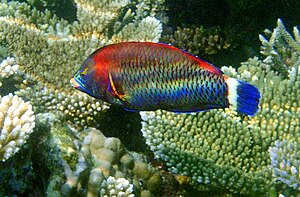Chisel-tooth wrasse
| Chisel-tooth wrasse | ||||||||||||
|---|---|---|---|---|---|---|---|---|---|---|---|---|

Chisel-tooth wrasse ( Pseudodax moluccanus ) |
||||||||||||
| Systematics | ||||||||||||
|
||||||||||||
| Scientific name of the genus | ||||||||||||
| Pseudodax | ||||||||||||
| Bleeker , 1861 | ||||||||||||
| Scientific name of the species | ||||||||||||
| Pseudodax moluccanus | ||||||||||||
| ( Valenciennes , 1840) |
The chisel-tooth wrasse ( Pseudodax moluccanus ) is a species of fish that is related to perch . It lives in the Red Sea and in the entire tropical and subtropical Indo-Pacific from South and East Africa to Japan , Australia (also on the south coast) and to the Society Islands , the Marquesas and Tuamotu . It lives as a loner or in pairs in outer reefs at depths of up to 40 meters.
features
It differs from all other wrasse by its unusual, protruding teeth. Its body shape is slender and narrow, similar to that of the Anampses species. Adult animals are brown in color, with a dark brown spot in the middle of each scale. The top of the front body and the dorsal fin are orange. Dorsal, ventral and anal fins lined with blue. The caudal fin is black with a wide, vertical, yellow band at the root. The pectoral fins and the upper lip are yellow, a small blue longitudinal band runs from the tip of the snout to the lower edge of the gill cover. Males and females are colored the same. The dorsal fin has eleven hard rays and twelve soft ones. The anal fin three hard and 14 soft. Chisel-tooth wrasse grow to be 25 to 30 centimeters long.
Juvenile chisel-tooth wrasses are slimmer, light blue with a broad, dark longitudinal band. They are similar to the cleaner wrasse and, like them, also clean other fish of parasites .
Adult animals feed on small, hard-shelled invertebrates.
Systematics
The teeth of the chisel-tooth wrasse differ so much from other wrasse that it was placed in its own subfamily, the Pseudodacinae. An association with the parrotfish , which also have strong but differently built teeth, was often assumed. Phylogenetic examinations place him as a basal member of the Lipfish (Hypseginyae).
literature
- Hans A. Baensch , Helmut Debelius a . a .: The joint maintenance of invertebrates and tropical marine fish in the aquarium. 3. Edition. Mergus, Melle 1997, ISBN 3-88244-110-0 ( Mergus Sea Water Atlas. Volume 1).
- Ewald Lieske, Robert F. Myers: Coral fish of the world. Year, Hamburg 1994, ISBN 3-86132-112-2 .
swell
- ↑ MW Westneat, ME Alfaro: Phylogenetic relationships and evolutionary history of the reef fish family Labridae. In: Molecular Phylogenetics and Evolution. 36, 2005, pp. 370-390
Web links
- Chiseltooth wrasse on Fishbase.org (English)
- Pseudodax moluccanus inthe IUCN 2013 Red List of Threatened Species . Listed by: Sadovy, Y., Pollard, D. & Rocha, LA, 2009. Retrieved February 8, 2014.